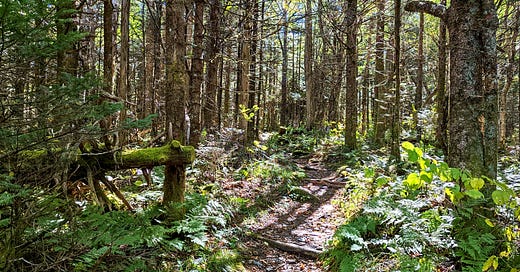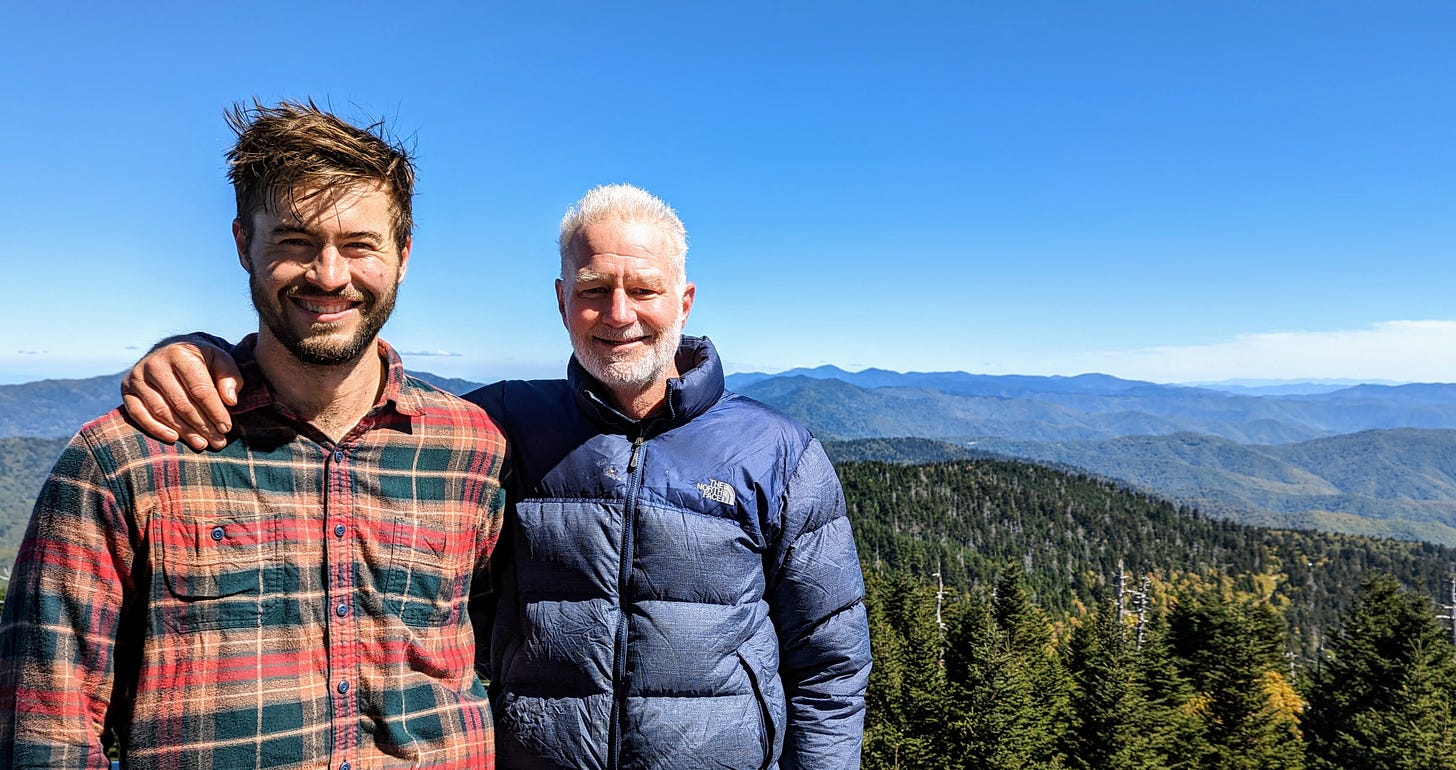Restoring the "Magic" of Ancient Forests, 1,000 Spruce at a Time
Logging, fires, disease and acid rain have devastated Southern Appalachia's spruce-fir forests, an iconic ecosystem left by the last ice age. A group in Lake Toxaway is helping to restore it.
LAKE TOXAWAY — My older son and I walked 41 miles last week on the Appalachian Trail, gained 4,700 feet in net elevation, and traveled back in time about twelve millennia.
It happened near the highest point on the AT, 6,600-foot Clingmans Dome, a transformation a little like Dorothy opening the door on Technicolor Oz.
We’d been hiking through beech and birch trees, pale, sawtooth leaves fluttering in the frosty wind, trunks spaced widely enough to offer glimpses of neighboring ridges in Great Smoky Mountains National Park.
Then, within a few steps, we were enclosed in green — a forest canopy of solid conifer needles, a loamy floor blanketed by moss and ferns.
This is one of the Southern Appalachian’s few remaining patches of spruce-fir forest, relics left on the highest, coolest mountain ridges after the retreat of the last ice age, Kelly Holdbrooks, executive director of Southern Highlands Reserve, told me after I’d returned.
“You saw when you were hiking how dramatically different these ecosystems are at high elevation,” she said. “Suddenly you’re like, ‘This is magical.’ ”
She said this Friday as she worked on spreading — or, more accurately — restoring this magic, dunking young potted red spruce trees into a nutrient-rich bath to prepare them for transplant on Virginia’s Whitetop Mountain.
The Reserve is magical in its own right, a 120-acre native-plant garden and research center on a 4,500-foot mountaintop in Lake Toxaway and one of the founding organizations of the Southern Appalachian Spruce Restoration Initiative (SASRI).
The aim of this public-private partnership is not to take the spruce-fir landscape all the way back to the end of the ice age, when it dominated even lower ground through much of the South, but to something close to the historic range of the late 19th century.
Quadruple Whammy
That was when the remaining tracts of this ecosystem began to be hit by what Holdbrooks called a “triple whammy.”
Actually, it was more like a quadruple whammy.
First, spruce were harvested for their valuable lumber. Then, according to the SASRI website, came “rampant wildfires” super heated by logging slash and destroying not just trees but their seeds and the loam needed for regeneration.
That was followed in the late 20th century by the spread of the exotic woolly balsam adelgid, which sickens and kills fir trees and, finally, by several devastating decades of acid rain produced by air contaminants such as sulfur dioxide.
These forces have combined to reduce the total spruce-fir acreage by about half, leaving only scattered tracts near the region’s landmark peaks, including Black Balsam Knob, Roan Mountain and, in Virginia, Mount Rogers and Whitetop.
So what my son and I saw was not just a relic, but the diminished vestige of a relic. Looking more closely at the forest, we noticed that the trunks of many evergreens were bare and spindly, that the thickest blankets of moss covered dead and fallen trees.
Fraser fir are a poor candidate for restoration because of the continued presence of the adelgid. And as hardwoods spread into these struggling forests, their thick leaf-fall accelerates this encroachment by suffocating spruce seedlings.
“Red spruce is not a great resprouter and gets outcompeted by hardwoods,” said Connor McBane, the natural resource manager of the Appalachian Trail Conservancy, another SASRI partner.
Spruce Pipeline

That leaves the introduction of well-established spruce trees as the most likely path to restoration. Producing them is the Reserve’s main role in the partnership, its nursery serving as a pipeline of young trees that will be steadily added to the total of the more than 5,000 SARSI has already planted.
Tiny, fern-shaped seedlings grow in trays in its two small greenhouses. Slightly older trees are arranged outside in pots — as were, until Friday, the 1,000 waist-high specimens earmarked for that day’s shipment.
All of them were between three and six years old and ready to go, Holdbrooks said. Or more than ready. The oldest of them had been cultivated for a scheduled replanting in nearby Pisgah National Forest that was delayed because of the bureaucratic requirements of the National Environmental Policy Act, Holdbrooks said.
She gets attached to plants and refers to them in the language of avid gardeners as her “guys.” She views their departure like a parent at graduation — sad at seeing them move on, excited about their future.
“It can be kind of bittersweet,” she said, “but we are ready for these guys to go. They’ve been here for too long. They need to go to their forever home.”
She and the Reserve’s director of horticulture, Eric Kimbrel, whose feelings were less mixed — “It’s work to keep them alive,” he said — treated the young trees to the dunking that would protect them from “transplant shock,” Holdbrooks said.
They then packed the first load, a dense miniature conifer forest, onto the back of a flatbed truck, which Kimbrel drove a few hundred yards to a waiting U-Haul box truck that McBane and his crew had driven down from Virginia — and that they all began to load for the return trip.

Home on Whitetop
These saplings will be replanted by workers from the American Conservation Experience in six plots targeted to fill in gaps in the spruce-fir’s historic range. The idea, McBane said, is to create corridors of spruce-fir forest for the animals that depend on it, including northern saw-whet owls, black-capped chickadees, several species of salamanders and the federally endangered Carolina northern flying squirrel.
Mature spruce provide dense branches ideal for squirrel nests — or “dreys,” as biologists call them — and help the animals fight an intestinal parasite to which they are prone, Kimbrel said.
“When the little squirrel consumes nuts and pieces of barks, it gets some of that spruce oil, which has been proven to be anti-parasitic,” he said.
The cooperation between groups such as the Reserve, the Trail Conservancy, the US Fish and Wildlife Service and the US Forest Service — which manages the George Washington and Jefferson National Forest, where the trees will be replanted — has been crucial to SASRI’s success, Holbrooks said.
“We have worked so hard over the past decade to build these partnerships,” she said. “I think what is unique about SASRI is, we don’t compete with each other.”
This relationship leaves no doubt about the role of the Reserve, the location of which, on the lowest and southernmost edge of red spruce range, is perfect for for nurturing the program’s saplings. Having been grown in these relatively warm surroundings, the trees can easily survive in the cooler, higher regions where they will take root.
This site has also created slight genetic variations that should allow its strain of spruce to thrive as climate change warms even higher elevations, McBane said.
Geneticists “recommended that we plant southern-latitude red spruce on Whitetop,” the second-highest mountain in Virginia, he said. “Their models show that in 70 years time, the viability of the red spruce that currently reside there is not great.”
The other factor giving newly planted trees a fighting chance is the reduction in acid-rain contaminants throughout the spruce-fir range, including the Smokies.
Though this problem has not been completely resolved, a sign at the viewing platform on Clingmans Dome warning of reduced views due to air pollution not only looked old; it seemed outdated. The air was clear enough that we could easily see Mount Mitchell about 50 miles due east, and the sprawl of Knoxville many miles to the northwest.
The National Park, home to the largest stands of spruce-fir forests, has declined to participate in the SASRI project, but we could also see, closer up, the stretches of the dense growth of evergreens we had just passed.
We have now nearly completed one of our hiking goals, covering all the North Carolina stretches of the AT. It also crosses Whitetop, which may be next on our list.
We could see mountains almost as high and rugged as the Smokies. Plus, we could check in on the guys.






Thank you for becoming such a valuable resident of western North Carolina! It is a wonderful place, and we are grateful for your dedication to excellent research and fine writing which allow all of us, natives and transplants, to learn more in depth about this special place and to become better stewards of everything--and everybody--that has made it so special!
Fascinating article, reminding us that there are devoted souls acting on their call to preserve a gift we all enjoy. Thank you!